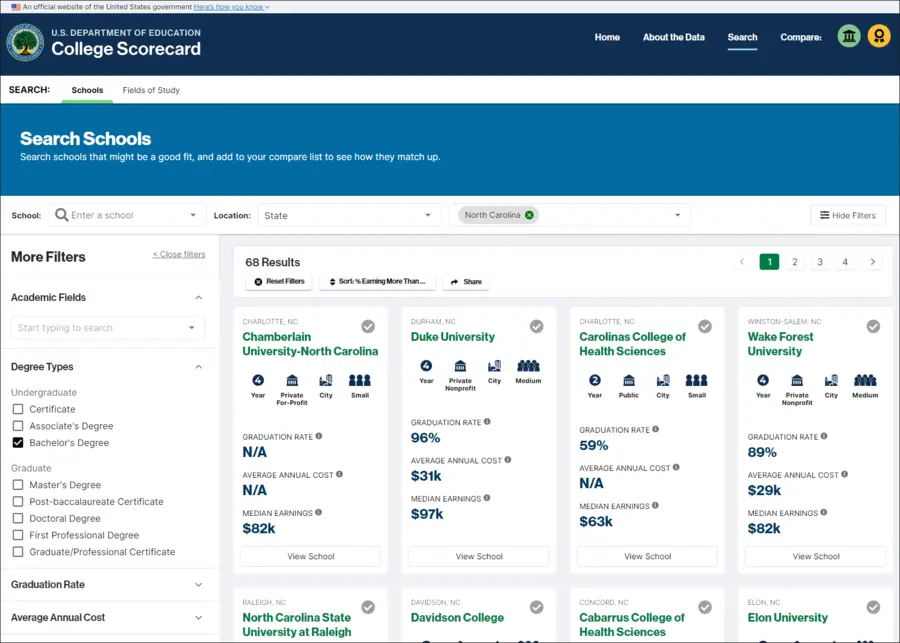Objective
To disseminate data to postsecondary education seekers, providing them critical information around access, affordability, and college outcomes.
Approach
RTI International constructed a dataset that combines data from the Integrated Postsecondary Education Data System (IPEDS), the National Student Loan Data System (NSLDS), the U.S. Department of the Treasury, and others and built a user-friendly website to help postsecondary education seekers access these data. The team also built an Application Programming Interface (API) that enables third-party developers to use the Scorecard data in their own applications and analyses.
Impact
With an average of 105,000 unique monthly visitors, College Scorecard is one of the U.S. Department of Education’s (ED’s) most visited websites. RTI is continuing to update and improve the Scorecard to benefit more users, provide more features, and make the website and API more responsive and accessible.
Giving Postsecondary Education Seekers the Data They Need to Make Informed Decisions
Postsecondary education seekers have many decisions to make about continuing their education after high school. How can they access the data they need on key factors like available fields of study, costs, student and faculty demographics, and more to help inform their decisions?
College Scorecard is an easy-to-use website created by ED that provides college and certificate seekers a wealth of postsecondary data in a user-friendly interface. This flagship data dissemination website combines information from IPEDS with data from NSLDS, the U.S. Department of the Treasury, and other sources to produce a historical dataset from 1996 to the present.

Screenshot of the College Scorecard Search function.
RTI is helping ED update and maintain the Scorecard, processing large amounts of complex data and turning them into actionable insights. The team also developed one of ED’s first public APIs, which enables developers and data scientists to use machine-readable data from College Scorecard and incorporate that data into their own website or use the data as part of their statistical analysis. This enables third-party developers to provide this free information to their users and allows researchers to use the data to examine college choice.
Through our partnership with ED, we are developing user-friendly ways to sift through institutional characteristics (such as enrollment data and student aid) so that prospective students can easily discover pathways into their desired careers and learn how they can pay for their education.
Developing a Modern, Accessible Education Data Dashboard
College Scorecard is mobile-responsive, accessible, and user friendly, helping users make data-driven decisions about their postsecondary education. Rather than looking at raw data, users can interact with select data visualizations on the Scorecard that ED has engaged with the various targeted audiences and determined to be the most important when it comes to “finding the right fit.”
Merging data from several sources to build one dataset and website was a complex process. Since 2015, RTI has developed, tested, and refined a series of programs that harmonize the data from across all sources and ultimately merge all the data into the Scorecard data files, which are shared with the public and disseminated through the API.
RTI used user experience (UX) and user interface (UI) tools, along with user testing and strategic outreach, to develop and display comparison data in a way that was easy to digest for the various College Scorecard audiences.
User testing is core to the development and implementation of the Scorecard. This testing involves recruiting test users to click around and test the functionality of the platform using wireframes prior to programming. These users give feedback to ensure that the data are easy to understand and accessible before they are implemented on the consumer-facing website. Based on this feedback, RTI provides ED with recommendations for what features and functionality should be implemented.
Supporting the Evolution of College Scorecard for Better Decision-Making
Given that the College Scorecard website is free and open access, it has been a tremendous resource for postsecondary decision making. The Scorecard is one of ED’s most visited pages, receiving on average 105,000 unique monthly visitors. In addition, the API has enabled users to build their own websites and apps and multiply the impact of the Scorecard.
In addition to supporting updates to Scorecard data, the RTI team is supporting design and feature updates for the consumer website. We are always trying to evolve and improve the Scorecard to benefit more users; provide more options; and make the website and API more useful, responsive, and accessible. As part of the feedback process, the team has emphasized making the website approachable to students and underrepresented populations and ensuring that it is easy to view from mobile devices and desktops. We are continuing to work with ED to identify future improvements to the website and API to disseminate Scorecard data better and help postsecondary seekers get the data they need to make decisions about their future.
- U.S. Department of Education





